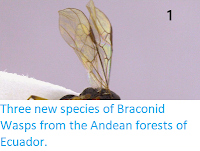Parazoanthid Corals are colony forming Soft Corals noted for their tendency to grow on other benthic filter feeding animals, typically Sponges but sometimes Corals or other organisms, a form of facultative parasitism in which the Parazoanthid benefits from currents generated by the larger organism, while at the same time covering part of its surface, reducing the host’s ability to feed itself. Parazoanthids usually lack symbiotic Algae, and inhabit dark environments such as marine caves and deep sea cold seeps, where there are few predators, but also little food and limited natural currents, and thereby rely on their host’s ability to generate a current to survive.
In a
paper published in the journal
ZooKeys on 29 December 2017, Hiroki Kise of the
Molecular Invertebrate Systematics and Ecology Laboratory at the
University of the Ryukyus, and the
Palau International Coral Reef Center,
Takuma Fujii, also of the Molecular Invertebrate Systematics and Ecology Laboratory at the University of the Ryukyus, and of the
Research Center for Island Studies Amami Station of
Kagoshima University, Giovanni Diego Masucci and Piera Biondi, again of the Molecular Invertebrate Systematics and Ecology Laboratory at the University of the Ryukyus, and
James Davis Reimer, once again of the Molecular Invertebrate Systematics and Ecology Laboratory at the University of the Ryukyus, and the Palau International Coral Reef Center, and of the
Tropical Biosphere Research Center of the University of the Ryukyus, describe three new species of Parazoanthid Soft Coral from the Indo-Pacific region. All are placed in the genus
Antipathozoanthus, which gets its name from its habit of overgrowing Antipatharian (Black) Corals.
The first new species described is given the name Antipathozoanthus obscurus, meaning ‘dark’ in reference to the dark environments in which it was found. The species was found in caves and crevices on reefs at depths of between 3 and 15 m, and, unusually, grew on a rocky, non-living substrate, where it was possibly able to survive due to strong currents generated by tidal action, which may have carried planktonic food into the caves. Polyps of this species reach 5-10 mm in height, with an oral disk that opens to a similar size in diameter, and have between 26 and 32 brown or orange tentacles. These polyps are connected by stolons which form a mesh-like network. The whole is covered by an encrustation of sand and other particles up to 8 mm in size. The species was found in the Okinawa Islands of Japan, and around Al Wajh Shaybarah on the Red Sea Coast of Saudi Arabia, which suggests a far wider distribution, probably encompassing the entire Indian Ocean and Western Pacific, and possibly further afield.
Specimen of Antipathozoanthus obscurus. Collected from Cape Bise, Motobu, Okinawajima Island, Japan (26°42'34.4"N, 127°52'49.2"E) at a depth of 5 m by James Davis Reimer. Kise et al. (2017).
The second species described is named
Antipathozoanthus remengesaui, in honour of
Tommy Esang Remengesau, Jr., the current president of the Republic of Palau, for his support of marine research and conservation in Palau. This species was found growing on colonies of Corals of the genus Antipathes growing around the entrances to caves at depths of between 9 and 40 m, at Kagoshima (Japan) and Palau in the Pacific Ocean, in the Maldives in the Indian Ocean and around Al Wajh Shaybarah on the Red Sea Coast of Saudi Arabia. Polyps of this species are white in colour and reach 3-8 mm in height, with oral disks up to 8 mm in diameter, surrounded by 40-42 pinkish, translucent tentacles up to 4 mm in length. These polyps are solitary, or only weakly connected by a poorly developed coenenchyma. This species also tends to develop a coating of sand particles, though these tend to be smaller, at 1-3 mm.

Antipathozoanthus remengesaui, colony connected by poorly developed coenenchyma with white polyps on Antipathes sp., collected from Blue Hole, Palau (7°8'29.4"N, 134°13'23.3"E) at a depth of 23 m by James Davis Reimer. Kise et al. (2017).
The final species described is named Antipathozoanthus cavernus, in reference to its habit of living in caves. This species was found growing on colonies of the Coral Myripathes around cave entrances and on steep slopes at depths of between 19 and 39 m in Kagoshima and the Maldives. Polyps of this species reach 3-10 mm in height and have an orange oral disk 4-15 mm in diameter, surrounded by 32-40 translucent tentacles up to 5 mm in length. The polyps are connected by a highly developed coenenchyma, and again the colony is coated in sand and other particles 1-8 mm in size.
Antipathozoanthus cavernus polyps connected by highly developed coenenchyme with orange ring around oral disk, collected from Siaes Tunnel, Palau (7°18'54.8"N, 134°13'13.3"E) at a depth of 39 m by James Davis Reimer. Kise et al. (2017).
























































